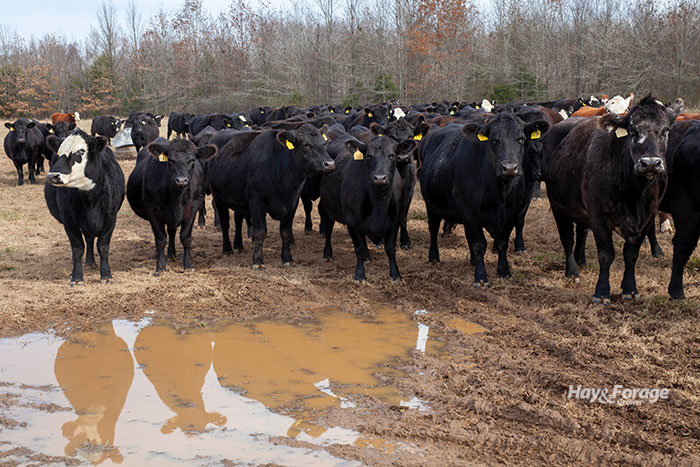Convert mud to productive pasture |
| By Amber Friedrichsen, Associate Editor |
|
|
 As springtime approaches, so does the transition from feeding hay to grazing livestock. With that said, even though pasture will start to green up soon, winter feeding areas might remain brown and rough from their earlier state of mud. Ed Rayburn, extension forage specialist with West Virginia University, says parts of a field that have experienced heavy hoof and machinery traffic during the winter are subject to mud in the spring as temperatures rise and more rain starts to fall. These areas will soon need to be restored to reduce soil erosion and compaction and promote pasture productivity. Prepare the area Reseeding forage is essential to protect bare soil, and seedbed preparation will vary depending on the size of the area and the extent of damage in a field. In places where hoof traffic has been kept to a minimum and the surface is relatively smooth, Rayburn suggests using a chain harrow to lightly work up the soil before seeding. “The chain harrow will usually open up the area sufficiently for seedling establishment,” Rayburn states. “Chain harrow the area, broadcast the desired seeding mix, and then chain harrow the area a second time to give some coverage to the seeds.” More intense damage requires additional attention, and Rayburn says producers can use a heavy field disk or blade to eliminate tire ruts formed while it was muddy. Then, use a cultipacker to firm the soil, broadcast seed, and drive the cultipacker over the area again to promote adequate seed-to-soil contact. Species selection When the same feeding area is used year-after-year, use annual forage species for reseeding. If feeding areas are rotated to different fields or areas, a mixture of annuals and perennials are justified. Rayburn recommends seeding warm-season annuals such as sudangrass or sorghum-sudangrass into muddy winter-feeding areas if supplemental summer forage is needed. Sudangrass and sorghum-sudangrass can provide ground cover and ensure feed in the summer when other forages are less productive. Allow these forages to grow to at least 18 to 30 inches tall before turning cattle out to graze. One thing to keep in mind about these species, though, is that they can produce prussic acid and threaten herd health later in the year. “When there is a risk of frost, remove animals from both of these grasses,” Rayburn says. “Once the grass has been killed by frost and is completely dried down, livestock can graze off the dead material without risk of prussic acid poisoning.” Other annual forages can be used to repair muddy winter-feeding areas as well; however, Rayburn points out that feeding areas can have high levels of nitrates. Although nitrates tend to accumulate lower in plant stems, these compounds can be toxic to livestock if consumed in large quantities. Rotating winter-feeding areas from year-to-year can lessen nitrate levels, distribute nutrients more evenly throughout a field, and ultimately reduce the formation of mud. Restoring muddy pastures can be costly, so Rayburn encourages producers to invest in a good chain harrow, purchase certified seed, and engage in proactive management practices. The forage specialist says to keep livestock off the reseeded winter-feeding areas until the seedlings have grown to 8 to 12 inches tall or 18 to 30 inches tall for sudangrass and sorghum-sudangrass. “Test the rooting of the seedlings by grabbing the plants by the leaves and pulling up firmly,” Rayburn explains. “If the roots stay in the ground and the leaves tear off the plant, the plants are well enough established to graze. Do not allow animals to graze off more than half the forage,” he adds.  Amber Friedrichsen Amber Friedrichsen served as the 2021 Hay & Forage Grower editorial intern. She currently attends Iowa State University where she is majoring in agriculture and life sciences education-communications and agronomy. Friedrichsen grew up on her family’s diversified crop and livestock farm near Clinton, Iowa. |
